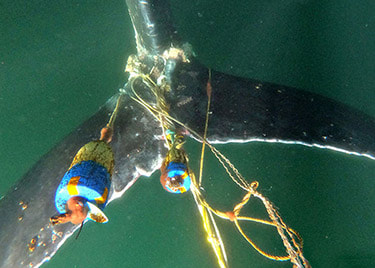|
On Saturday, May 16, 2020, Marine Life Studies' limited crew were out on the Monterey Bay National Marine Sanctuary conducting our research boat surveys. We received a calll from the California Department of Fish and Wildlife (CDFW) that they had an entangled whale. We arrived in 38 minutes to the area where CDFW's wildlife officers were standing by with the severely entangled humpback whale. Our crew are trained members of Marine Life Studies' Whale Entanglement Team (WET)®. We knew we had to act fast since the marine weather was changing and the wind was coming in. We deployed the drone, but the visiblity through the water wasn't great. The drone was an important tool for assessment and it gave us a good idea where the entanglement was on the whale and where the lines were in the water. The whale's tail was so weighted down, we could not see the entanglement from the boat. We couldn't see the whale's dorsal fin either, so we could not approach too closely until we knew what lines were coming off the whale and where they were in the water column. Photo to the right is the fluke of the humpback whale showing the severity of the entanglement. The team tried to attach a telemetry tracking buoy to the 35-40 foot whale but we lost the opportunity because the entangling lines shifted, pulling the buoys underwater on Saturday. We were concerned that heavy winds were coming, so we wanted to get the telemetry buoy on just in case it shifted the gear enough so the whale could drag it and leave the area. On Saturday evening, we planned to leave Moss Landing Harbor at 5:45 am on Sunday, including Marine Life Studies' Whale Entanglement Team (WET)®, and one member from Moss Landing Marine Lab Boat Ops and TMMC MBO, with the goal of attaching the telemetry buoy. We only had a very small window of opportunity because the forecast was for very strong winds. Fortunately, we were successful in attaching a telemetry buoy that morning, allowing for a multi-agency response the following day to complete the disentanglement.
The team found that the entanglement involved five sets of commercial dungeness crab gear. It is believed the whale first became entangled and began dragging a crab pot that caught four additional pots, associated lines and buoys. The weight of the five combined sets of gear stopped the whale from swimming.
The photo above is the fluke of this humpback whale. We hope to get a resight on this animal. If you see this animal please document the location (latitude/longitude) if you can, take photos while maintaining a distance of 100 yards from the animal, and send it to us at: https://www.hightail.com/u/MLS Entangled whales can be dangerous and should be approached only by trained response teams authorized by NOAA Fisheries. Entanglement Response Network partners receive training from NOAA Fisheries and invest much of their own time in training for and responding to entanglements. We are grateful for all of our entanglement response partners along the West Coast. Prompt reporting is the best way to help an entangled whale. Report entangled whales on the West Coast to the 24/7 hotline by calling (877) SOS-WHALe / (877) 767-9425 or hailing the U.S. Coast Guard on VHF Channel 16. Safety is our #1 priority at Marine Life Studies during the COVID-19 pandemic. We are fortunate that we can continue to conduct our research surveys with a very limited crew to monitor the whales for the California Dungeness Crab Fishing Gear Working Group. Our Executive Director contacted the local health department to make sure we weren’t putting our crew and their families at risk when the shelter-in-place order went into effect in March 17, 2020. We assured them that we would be wearing masks as well as practice social distancing of staying 6 feet away from each other on our 40-foot Whale Rescue Research Vessel and practice thorough hand washing/sanitizing and sanitation of all equipment continuously throughout the day. Other than a few days a week on the vessel, we are conducting all other work remotely and volunteers are sheltered in place. Data that we collect during our research surveys is shared with the California Dungeness Crab Fishing Gear Working Group and the National Marine Sanctuaries. This information will inform the Risk assessment and Mitigation Program (RAMP) of the California Dungeness Crab Fishing Gear Working Group to reduce the risk of entanglement in fishing gear. This working group was convened by the California Department of Fish and Wildlife, in partnership with California Ocean Protection Council and National Marine Fisheries Service, to address large whale entanglements. Thank you for your support! We will keep you informed about this developing situation. We will continue to bring you on our adventures, at a distance! Stay safe and healthy, everyone!
0 Comments
Leave a Reply. |
AuthorWrite something about yourself. No need to be fancy, just an overview. ArchivesCategories |

© Marine Life Studies. All rights reserved.
PO Box 163, Moss Landing, CA 95039
[email protected]
Marine Life Studies is a 501(c)(3) nonprofit organization, founded in 2006.
EIN #: 27-0318674
PO Box 163, Moss Landing, CA 95039
[email protected]
Marine Life Studies is a 501(c)(3) nonprofit organization, founded in 2006.
EIN #: 27-0318674







 RSS Feed
RSS Feed